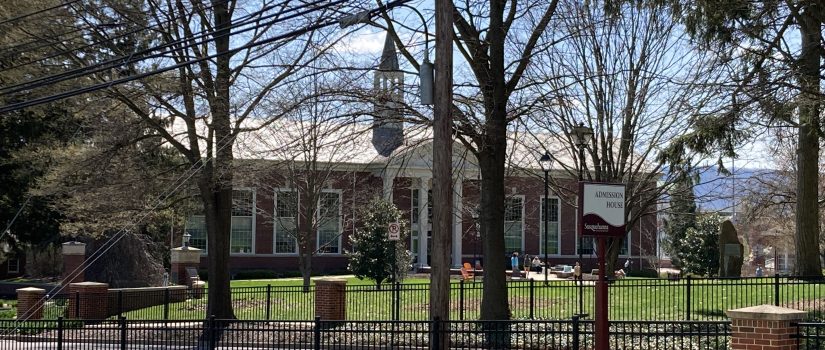Getting To Know: Susquehanna University (PA)
Central Pennsylvania is rich in liberal arts educational opportunities. Susquehanna University sets itself apart with in-depth global experiences as well as interesting programs in business, creative writing, education and music. Susquehanna University has 2,200 undergraduates. Virtually all live on campus, unless they are studying abroad or away within the US.
Until I visited Susquehanna, I knew of only one other National Liberal Arts college that has an AACSB-accredited business school,: Bucknell University, which is only a half hour away. However, Bucknell is larger, by over 1,400 undergrads, far more selective, and also grants graduate degrees. Aside from offering one master’s program in teaching, Susquehanna is totally focused on undergrads. If you’re serious about business, want a small school, and on your way to or from Bucknell, you might want to stop by at Susquehanna.The admissions office made me feel quite welcome. They do more for incoming students, ringing these cowbells when a new freshman or transfer student commits to deposit.
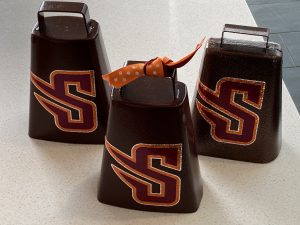
Susquehanna University has an easily walkable campus. It’s also easy to find parking here, a task at many colleges of any size. All students can have cars, and pay only $30 for a parking permit.
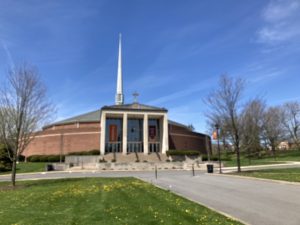
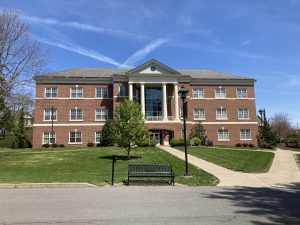
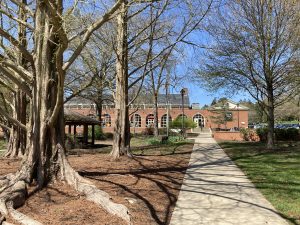
More impressive than the outsides of buildings were attention to collaborative learning spaces (example below). Renovations to the existing spaces have been a higher priority over new construction. The library really stood out as a place to accommodate group work.

Leadership and followership are part of the university mission statement.
The university follows through on this mission by having career advising tightly coordinated with academic advising,.civic engagement and fellowship advising. Susquehanna’s career development center has eight full-time professionals. That’s a large staff considering the size of the student body.
The advising process starts early at Susquehanna through an open door policy, career readiness courses and various events. This is extremely important at a school that has over 100 options for majors and minors, with 67 possible minors alone. It’s quite possible to run into two students who have the same major, but different options for minors or a second major. There’s more of a feeling about “putting the liberal arts to work” here than at many other small schools I have visited.
More interesting, over 300 alumni volunteer for career-related events. Sixty percent of on-campus recruiters are actually alumni. As a result of these efforts, 78 percent of the most recent graduates are employed and 18 percent have continued their education.This is quite comparable with schools that have ultra-selective admissions.
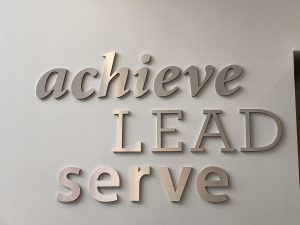
The students that I met seemed happy with their experience
Thanks to the admissions office and some ground work on my own I talked to more students that I usually do at other liberal arts schools. They seemed to be happy with their experience and an opportunity to design their degree programs around personal interests. I read Niche student reviews of this school after I got home.One consistent positive; students believed that the faculty cared about them.
.Susquehanna has a “true” student-faculty ratio of 12 to 1, meaning that any class will be taught by a professor versus a teaching assistant. Only one class out of more than a 630 had more than 39 students; none had more than 49. This school also has a president, Jonathan Green, a musician, who appears to enjoy blogging, mingling with the students and making his own YouTube addresses.
Two-thirds of the freshman who entered in 2015 graduated on time, about the same as Penn State or Pitt, but better than Temple or any school in the Pennsylvania State System of Higher Education. Seventy percent who entered the year before also finished in four years. Eighty-seven percent of the students who entered in Fall, 2020 returned for sophomore year. These numbers are quite good for a small private college.
Global experiences are the best reason to consider Susquehanna.
The university offers Global Opportunities aka ‘GO Programs’ over breaks during and between semesters, summers, full semesters or a full year. Every student will have at least one Global Opportunity, some will do more. Susquehanna has a six-week break between winter and spring, so it’s possible to earn credits or do meaningful work or community service. The business program guarantees every student an international internship. Because of these programs and the undergraduate focus of the school 90 percent of a class will graduate with some research or internship experience.
Susquehanna also offers “study away” experiences within the US. One is the Lutheran College Washington Semester. This is a unique consortial partnership between 12 Lutheran colleges plus Gettysburg, which has no religious affiliation. This experience includes academic coursework, an internship experience and confortable housing by the Metro stop in Rosslyn, Virginia. This program is a great opportunity for students interested in communications, politics, public policy or the arts.
Susquehanna University is very much a campus-based community.
Selinsgrove has dining places that parents will love. I’d happily make graduation reservations at the Selinsgrove Inn where I stayed for this visit. But I did not see much for students to do in town. The popular suburban shopping (like Target) and dining options (like Panera) are two or three miles from campus, and there’s plenty of outdoor recreation options nearby, but you need access to a car to get to them. Susquehanna competes in the Landmark Conference in 22 sports. Until recently it was in the Centennial Conference for football. But the Landmark Conference added two schools, Wilkes and Lycoming, that play football, so the Riverhawks will compete in that conference next season.
.About a fifth of the student body are members of Greek social fraternities or sororities. Twelve of these organizations have houses on campus. While there are over 150 other clubs and organizations on campus, and the Greek organizations don’t dominate the community, this is a significant interest group.
Susquehanna competes in a tough market for students-but it might undercut Home State U and Neighboring State U.
.Pennsylvania has more private liberal arts colleges than any other state, so each school tries to separate itself in some way beyond selectivity. Susquehanna has been test optional for some time and attracts a B+ student who has some idea of the school’s offerings. The acceptance rate for applicants for the Class of 2025 was 88 percent. The average high school GPA for the class of 2025 was a 3.67. Two-thirds of the students come from Pennsylvania, though I also met students from New England states, Maryland, New Jersey and Virginia.
Test scores are considered Important–but only if you submit them. Only 45 percent of the Class of 2025 submitted SAT scores. The middle 50 percent were between 1090 and 1250. Only five percent submitted ACT scores. The middle 50 percent for the ACT Composite was between 22 and 28. Students who are serious about the music programs must audition.
Susquehanna estimates that next year’s total cost of attendance will be $73,000 for a resident student. However, the merit-based scholarships are quite generous and easy to keep by maintaining good academic standing, The average merit-based scholarship for the Class of 2025 was over $36,000. Need-based scholarships, awarded to over 80 percent of the class, averaged $38,600. However, high indebtedness can happen here since there are added costs associated with having an international experience.
Conclusions
Susquehanna can be an affordable alternative to a flagship or regional public college when you can find an academic fit. The advising provided early in the education really helps students to make well-informed academic and career decisions, learn to work in groups and get outside of a comfort zone in an international experience. This school does a great job with the students it attracts.
Report Card: Susquehanna University
- Four-Year/Six-Year Graduation Rates: A
- Freshman Retention: B+
- Costs: B+
- Curriculum: A
- Community: B
- Comforts: B
- Connections: A (Pennsylvania/NY-NJ/Baltimore-Washington Corridor/ C Elsewhere
Want to know more about me?
Listen to my latest interview on ‘Tests and the Rest’ with Amy Seeley and Mike Bergin now!
Listen to my talk, What Exactly Is a Good College? hosted by test-prep experts Amy Seeley and Mike Bergin on Tests And The Rest!
Listen to my talk, College Is A Learning AND Living Community hosted by Dr. Cynthia Colon from Destination YOUniversity on Voice of America Radio!
Sharing is caring!

